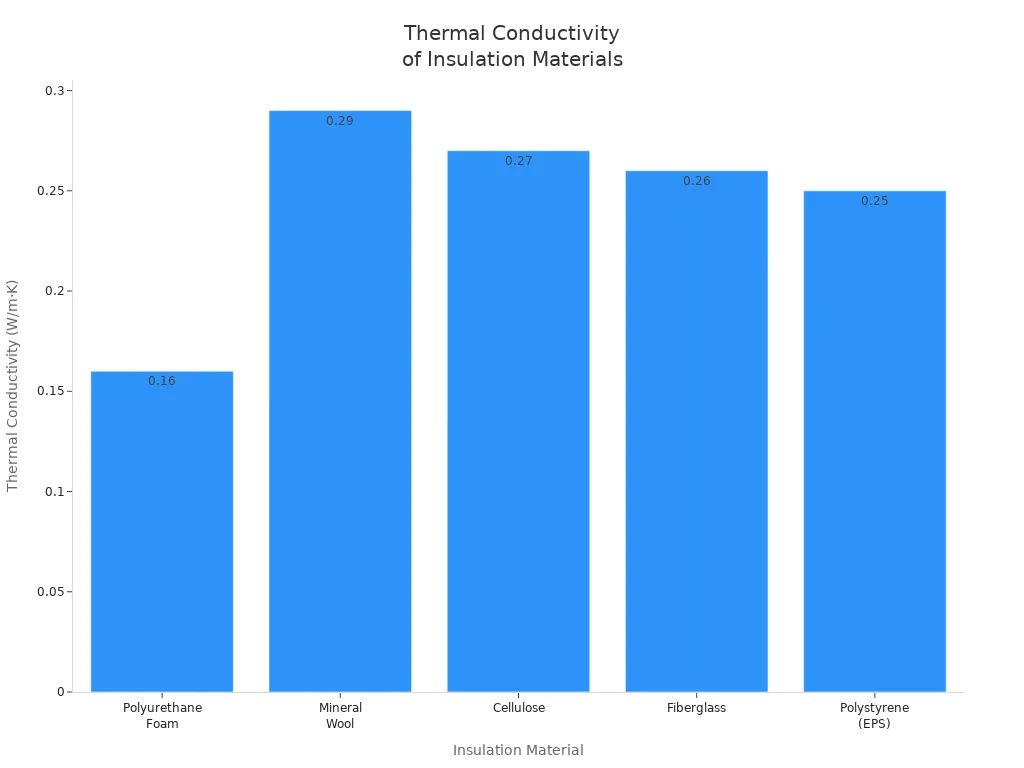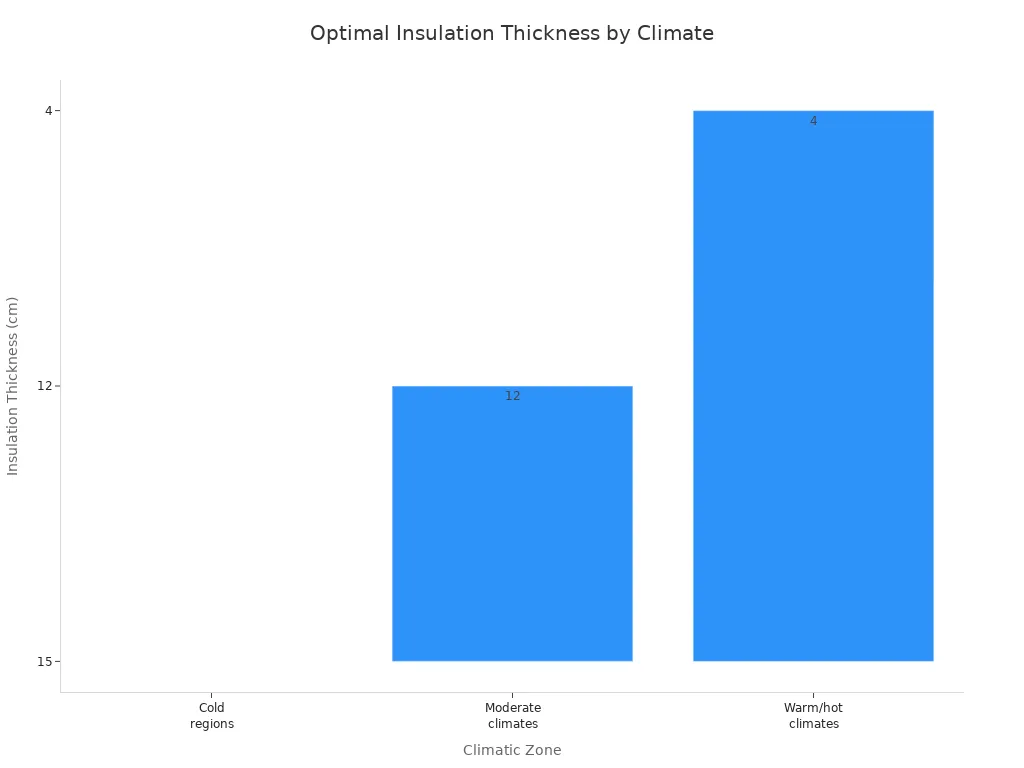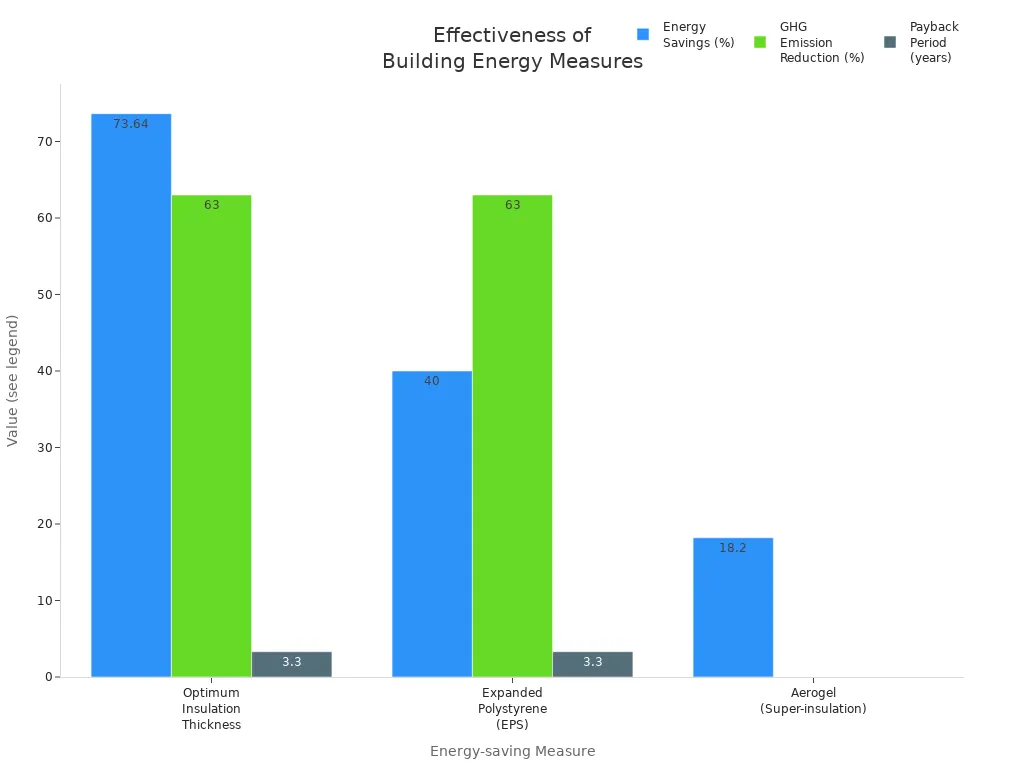Views: 0 Author: Site Editor Publish Time: 2025-08-22 Origin: Site
Increasing thermal insulation thickness lowers heat loss. But, each new layer helps less than the last one. Thermal insulation works like a barrier. It slows down heat moving by conduction, convection, and radiation. Rules show that adding 0.03 to 0.05 meters of insulation at home can change temperatures. It can also stop freezing damage. Many people believe thicker insulation keeps heat inside. But it really just slows down heat moving out. Good insulation brings more comfort at home. It also saves energy and money. Think about adding blankets on a cold night. Each blanket helps, but after a while, more blankets do not help as much.
Thicker thermal insulation keeps more heat inside. It helps save energy and money. Homes feel warmer and bills go down.
Each new layer of insulation helps less than the last one. There is a point where adding more does not save much money.
Insulation materials work in different ways to stop heat. Picking the right type and thickness depends on your climate. It also depends on what your building needs.
Sealing air leaks before you add insulation makes it work better. It helps keep heat inside your home.
Using tools can help you choose the best insulation thickness. Following local building codes is important for homes and factories.
Thermal insulation is used to slow down heat moving. People use it to keep homes warm in winter and cool in summer. It acts like a wall that blocks heat from passing through. There are many kinds of thermal insulation, and each one works a bit differently. Good thermal insulators trap air or gas in tiny spaces. These spaces make it hard for heat to get through. Bad thermal insulators, like metal or glass, let heat move fast.
The table below shows some common insulation types and how well they stop heat:
| Insulation Material | Approximate R-Value per Inch | Thermal Conductivity (k) Approximation |
|---|---|---|
| Polyurethane Foam | R-6.3 | ~0.16 W/m·K |
| Mineral Wool | R-2.8 to R-3.5 | ~0.29 to 0.36 W/m·K |
| Cellulose | R-3.1 to R-3.7 | ~0.27 to 0.34 W/m·K |
| Fiberglass | R-2.9 to R-3.8 | ~0.26 to 0.34 W/m·K |
| Polystyrene (EPS) | R-4 | ~0.25 W/m·K |
If a material has a higher R-value, it stops heat better. People pick the right insulation by thinking about weather and price.

Insulation slows heat in three main ways:
Conduction: Materials like fiberglass or foam stop heat from moving through solids.
Convection: Insulation holds air or gas in small spaces. This keeps air from moving and taking heat away.
Radiation: Some insulation uses shiny surfaces, like aluminum foil, to bounce heat back.
Fibrous materials, like mineral wool, hold air and slow both conduction and convection. Cellular materials, like polystyrene foam, have gas-filled cells that block heat. Reflective insulation uses shiny surfaces to send radiant heat away. Bad thermal insulators, like metals, do not trap air and let heat move easily.
New insulation types include aerogels and bio-composites. These can stop heat well even if they are thin. For example, aerogel can lower heating and cooling needs with just a thin layer. Composite insulation made from natural fibers also works well in places like mining tunnels.
Tip: Sealing air leaks helps insulation work better. This makes any thermal insulation do a better job at stopping heat loss.
How thick thermal insulation is matters a lot. It affects how much heat leaves a building. If a wall or roof has more insulation, less heat gets out. Scientists use something called the U-value. It shows how easily heat moves through a material. A lower U-value means better insulation. It also means less heat loss.
This link between thickness and heat loss is proven. Studies show thicker insulation lowers the U-value. This means heat loss goes down. For example, more insulation in a wall keeps a building warmer in winter. It also keeps it cooler in summer. The formula for heat loss is:
Heat Loss = U-value × Surface Area × Temperature Difference × Time
When insulation gets thicker, the U-value drops. This leads to less heat loss over time. Computer models and real tests agree. Thicker insulation in walls and roofs slows heat transfer. Buildings with more insulation use less energy. This saves money and keeps people comfortable.
The table below shows how more insulation changes U-value and heat loss:
| Insulation Thickness (mm) | U-value (W/m²·K) | Relative Heat Loss |
|---|---|---|
| 50 | 0.60 | High |
| 100 | 0.35 | Medium |
| 200 | 0.18 | Low |
| 300 | 0.12 | Very Low |
Note: Thicker insulation means a lower U-value and less heat loss.
Adding more insulation always helps. But each new layer helps less than the last one. This is called "diminishing returns." At first, a little insulation makes a big change. Later, adding more does not cut heat loss as much.
Doubling the R-value cuts heat loss in half. But after a while, more thickness helps only a little.
Tests show the first few inches of insulation help most. For example, closed cell foam panels help less after about 7 inches in cold weather.
The starting amount of insulation and wall design matter. They change when diminishing returns begin.
Warmer places reach diminishing returns with thinner insulation than cold places.
R-value shows how well insulation stops heat flow. Thicker insulation means a higher R-value. For most materials, doubling thickness doubles the R-value. This means better heat resistance. Some types, like loose-fill, may not increase as much if pressed down.
Here is a simple list showing how insulation thickness affects energy use:
Roof insulation can lower energy use by 35–45%.
Wall insulation can cut energy use by about 15%.
Thicker insulation keeps homes warmer in winter and cooler in summer.
There is a best thickness for each climate and building type. Adding more after this point costs more but saves less energy.
Tip: The best insulation thickness depends on climate, building design, and cost. Too much insulation may not be worth the extra money.
People use insulation in many places. It keeps homes warm in winter and cool in summer. Attic insulation is very important for saving energy. Walls, floors, and crawl spaces also need the right amount. For example, 2x4 wall framing often uses batts with R-13 to R-15. This is about 3.5 inches thick. Homes with 2x6 framing can use thicker batts, like R-19 to R-21. These give better protection from heat and cold.
Factories use insulation for pipes, tanks, and machines. These places can get very hot or cold. So, they need thicker and stronger insulation. Yufeng Refractory makes ceramic fiber blankets and boards. These work well for high-temperature equipment. Their insulation helps factories save energy and keeps workers safe from hot surfaces.
Tip: Always seal air leaks before adding insulation. Closing gaps helps insulation work better.
The table below shows how thick insulation should be in different home areas:
| Area | Typical R-Value | Approximate Thickness |
|---|---|---|
| Attic | R-22 to R-49 | 7–13+ inches |
| Exterior Walls (2x4) | R-13 to R-15 | ~3.5 inches |
| Exterior Walls (2x6) | R-19 to R-21 | ~5.5–6.25 inches |
| Crawl Space Walls | R-11 to R-19 | Varies |
Yufeng Refractory’s ceramic fiber boards can be used in homes and factories. These boards resist heat and water. They are a good choice for better thermal insulation in many places.
The right insulation thickness depends on climate, building codes, and insulation type. The International Energy Conservation Code (IECC) splits North America into eight climate zones. Each zone has its own R-value rules for walls, roofs, and floors. For example:
Find your climate zone on a DOE or IECC map.
Check what R-value you need for your home’s walls, attic, and floors.
Choose insulation that meets or goes above these values.
Note: Local building codes may have extra rules. Always check before you start.
Using the right thickness saves money and keeps homes comfy. In factories, insulation must handle tough conditions. Yufeng Refractory’s products, like ceramic fiber blankets, have high R-values with less thickness. This helps meet safety and energy rules.
Factory insulation must also think about pipe size, temperature, and wetness. Bigger pipes or colder places need thicker insulation. Tools like the U-Value Calculator or Energy Loss Calculators can help. These tools use your project details to suggest the best thickness.

Here are some tips for better home insulation:
Use the right insulation for each area.
Do not squish insulation, or it will not work as well.
Cover the whole area to stop heat from escaping.
Ask a pro for help if you are not sure.
Government rebates and tax credits can help pay for insulation. These programs help people add more insulation, especially in attics, to save energy and feel more comfortable.
Tip: Online calculators and expert advice can help you pick the best insulation thickness for your home or factory.
Putting in more insulation helps stop heat from escaping and saves energy. But after a while, adding more does not help as much and costs more money. Homeowners need to think about how much they pay at first and how much they save later. The table below shows how different insulation types work over time:
| Insulation Type | Upfront Cost | Annual Savings | Payback (years) |
|---|---|---|---|
| Spray Foam | High | High | 3–7 |
| Fiberglass Batts | Low | Moderate | 2–4 |

Checking your insulation often and asking an expert can help it work better. Picking the right thickness makes your home more comfortable, saves money, and helps the planet.
Thermal Insulation keeps heat inside during winter. It blocks heat from coming in during summer. This helps people use less energy. It saves money on bills. Homes and factories feel more comfortable with good insulation.
Thicker Thermal Insulation means less heat escapes. People do not need as much energy to heat or cool rooms. Bills go down when heat stays inside longer. The right thickness gives the most savings.
Materials like fiberglass, mineral wool, and polyurethane foam trap air. These materials slow down how fast heat moves. The table below shows some common choices:
| Material | R-Value per Inch |
|---|---|
| Fiberglass | 2.9–3.8 |
| Mineral Wool | 2.8–3.5 |
| Polyurethane Foam | 6.3 |
Thermal Insulation can help make rooms quieter. Fiberglass and mineral wool soak up sound waves. People notice less noise when walls and ceilings have insulation.
Colder places need thicker Thermal Insulation. Warmer places use less. Building codes and climate zones help people pick the right thickness for where they live.